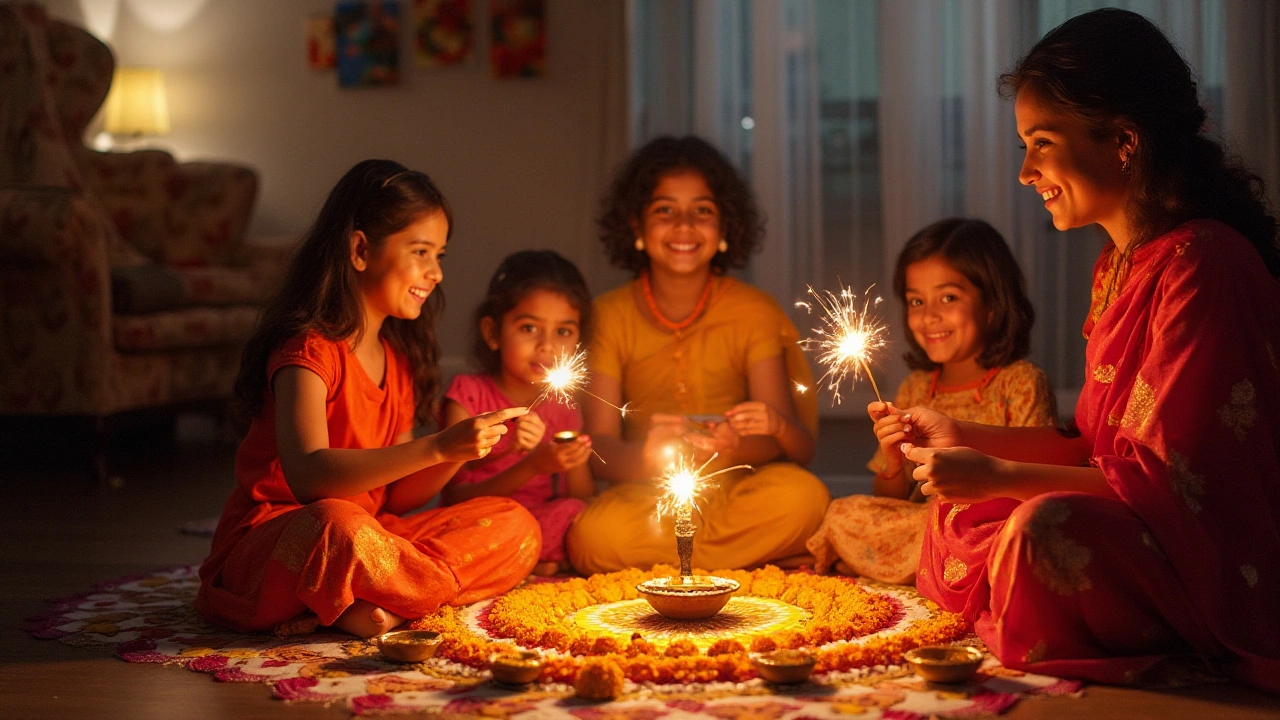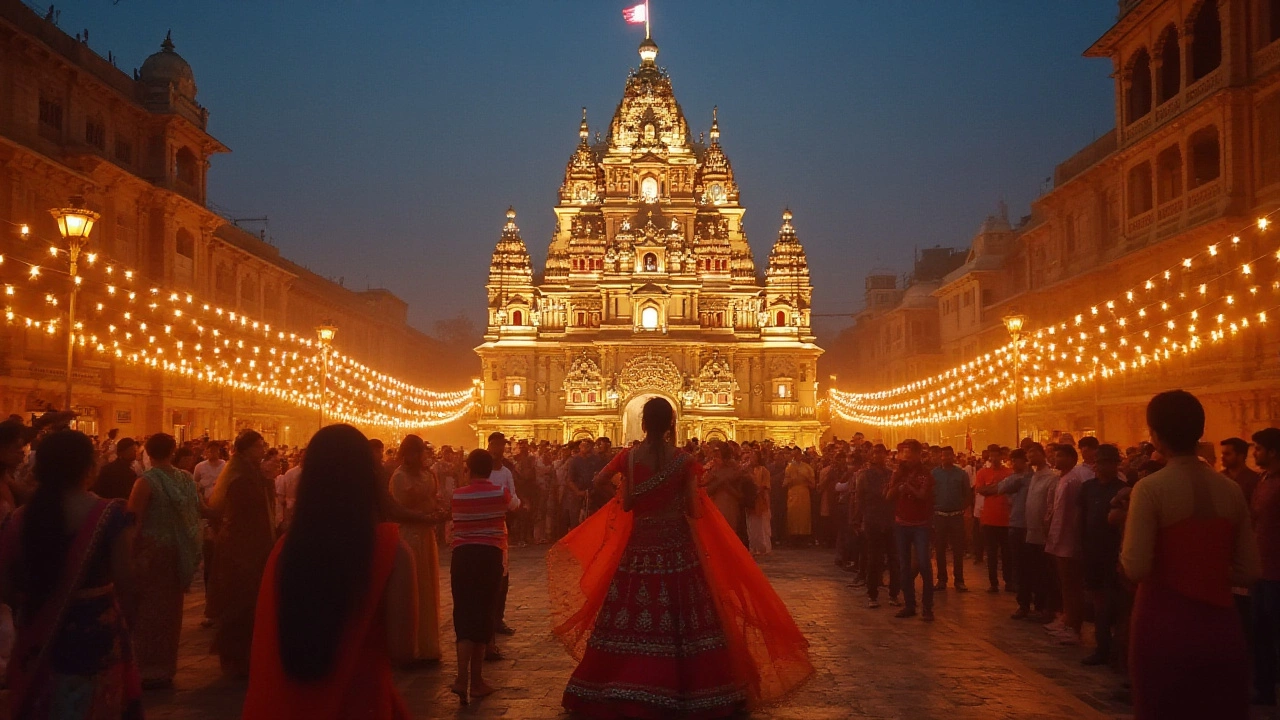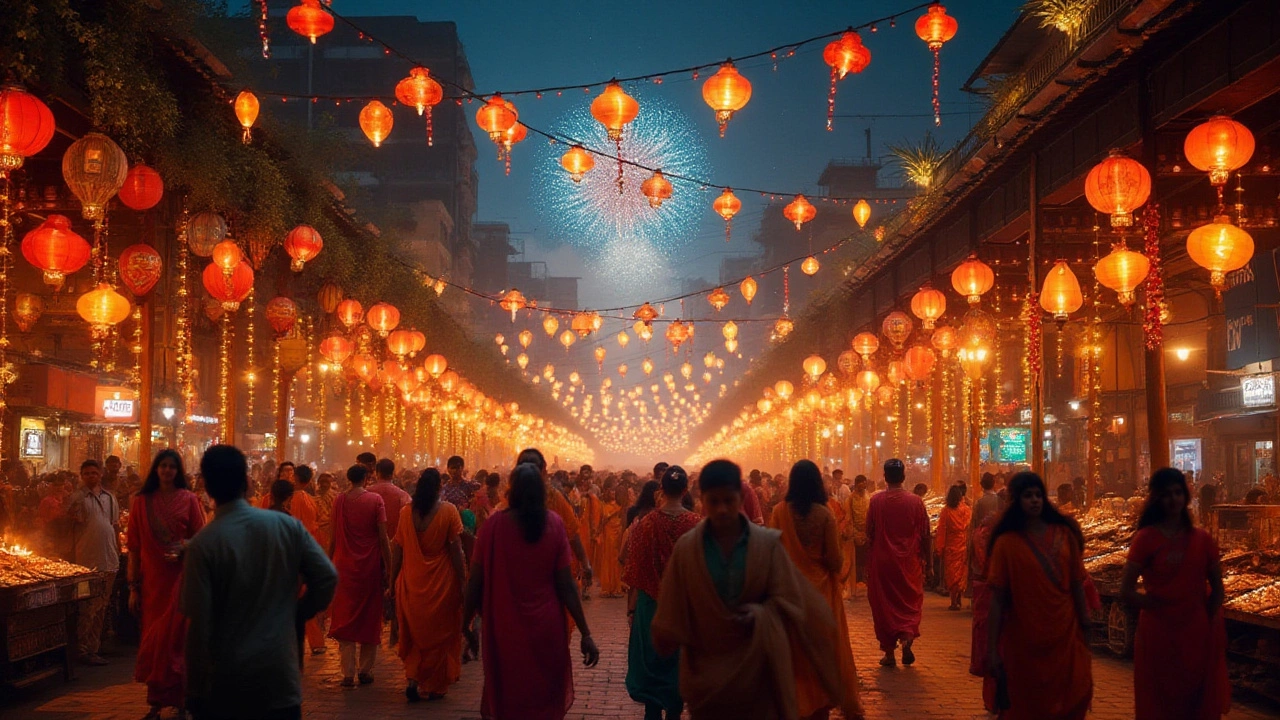Diwali, often referred to as the Festival of Lights, captivates the heart of India with its vibrant and joyous celebrations. More than just a festival, Diwali is a symbol of hope, prosperity, and the triumph of good over evil. For visitors, it offers a gateway to understanding the rich tapestry of Indian heritage, deeply interwoven with spirituality and festivity.
The origins of Diwali are deeply rooted in ancient Indian mythology and are celebrated with various traditions across the country. Over five auspicious days, families decorate their homes with lamps, exchange sweets, and participate in elaborate temple rituals. These rituals offer glimpses into India's diverse cultural fabric.
Travelers eager to immerse themselves in the Diwali experience should consider embarking on temple tours that showcase the beautifully lit shrines and community gatherings. Whether you find yourself in bustling cities or tranquil villages, the spirit of Diwali welcomes you into a world of warmth and camaraderie. It's an experience that not only illuminates the night but also the soul, leaving an indelible mark on all who partake in its magical allure.
- The Origin and Significance of Diwali
- Five Days of Celebration Explained
- Diwali's Impact on Indian Culture
- Experiencing Diwali through Temple Tours
- Regional Variations in Celebrations
- Tips for Travelers during Diwali
The Origin and Significance of Diwali
At the heart of **Diwali** lies a profound tapestry of legends and stories that have been passed down through generations, celebrating the victory of light over darkness and good over evil. This illustrious festival, known as the Festival of Lights, holds a deep spiritual significance for millions of Hindus around the world. While the interpretations of Diwali can vary, it is primarily linked to several primary themes rooted in ancient Indian epics. One of the most popular of these is the return of Lord Rama to his kingdom Ayodhya, along with his wife Sita and brother Lakshmana, after 14 years of exile. Their return, triumphing over the demon king Ravana, is celebrated with great joy and fervor. As the legend goes, on the day of their homecoming, people lit oil lamps (diyas) along the streets, symbolizing the dispelling of darkness and ushering in a new era of hope and joy.
In other regions, **Diwali** is associated with other deities and legends, showcasing the rich diversity of Indian culture. For example, in some parts of India, the festival commemorates the victory of Lord Krishna over the tyrant Narakasura, while in the state of Gujarat, it is linked with the worship of Lakshmi, the goddess of wealth and prosperity. These variations highlight the cultural mosaic of India, where each region imbues Diwali with its own distinctive flavor and significance. Despite these regional differences, the festival universally embodies the themes of renewal and the human spirit's capacity to overcome adversity and celebrate life.
Diwali is not just a religious event but a cultural festival that has resonated across borders and religions, becoming a symbol of unity and togetherness. It also marks the start of the financial year in some business communities, where new account books are sanctified and opened in a ritual known as Chopda Pujan. Services and tradespeople often consider Diwali as an auspicious time to launch new ventures and projects. This widespread acceptance underscores the festival's economic and social implications beyond its religious roots, emphasizing the essential values of generosity, goodwill, and new beginnings.
"Diwali has transcended its origins as a Hindu festival to become an essential cultural phenomenon celebrated with zest the world over," noted historian Sunil Khilnani in his lecture on Indian traditions, emphasizing the festival's vast cultural outreach.
The grandeur with which **Diwali** is celebrated is often reflected in the dazzling fireworks that light up the skies, a colorful testament to the festive spirit that grips entire communities. Families gather to parttake in prayers and rituals, drawing elaborate rangolis—traditional colorful floor designs—at their doorsteps to welcome guests and prosperity into their homes. The symbolic significance of light, inherent to the festival, transforms neighborhoods into beacons of hope and invitations to joy. Diwali also serves as a poignant reminder of the role mythology and storytelling play in preserving and interpreting cultural values, binding individuals through a shared heritage of beliefs and customs.
Five Days of Celebration Explained
Diwali unfolds over a span of five mesmerizing days, each with its unique rituals and significance steeped in Indian festivals and tradition. It begins with Dhanteras, a day devoted to wealth and prosperity. On this day, families clean their homes and shop for gold or utensils, believed to bring good fortune. Markets buzz with shoppers and streets light up with festive decor, marking the anticipation of the days to come. This day sets the stage for the community to come together, sharing joy and spreading the message of prosperity for all.
The second day, known as Naraka Chaturdashi or Choti Diwali, focuses on the victory of light over darkness, echoing the essence of the Diwali festival. The mythological tale of Lord Krishna's triumph over the demon Narakasura is commemorated, highlighting the significance of good vanquishing evil. Traditionally, people wake up early and bathe using fragrant oils and herbs, a ritual thought to purify the body and soul. Families then adorn their homes with colorful rangolis made from vibrant powders, flowers, and colored sand, offering a visual feast that delights both locals and tourists alike.
The third day is the highlight, celebrated as Diwali, or the main festival of lights. Homes are aglow with the sparkle of lamps and candles, and fireworks light up the sky, creating an aura of enchantment. This evening, people pay homage to the goddess Lakshmi, inviting her blessings into their homes. Temples become focal points of devotion and celebration, and travelers participating in temple tours can witness the blend of spirituality and festivity distinctly unique to this day. "Diwali is not just a festival; it's a culture of joyous sharing and unity," remarks Arundhati Roy, highlighting the festival's deeper societal resonance.
The fourth day, known as Govardhan Puja or Annakut, celebrates Lord Krishna's act of lifting Mount Govardhan to protect villagers from torrential rains. On this day, offerings of food are made, symbolizing gratitude and communal harmony. Devotees create vast spreads of sweets and savory dishes, embodying a feast of abundance shared among neighbors and visitors. The spirit of sharing resonates through every community, bringing people together regardless of differences. Temple ceremonies are particularly vibrant on this day, offering a unique spectacle for those on temple tours.
The final day is Bhai Dooj, a beautiful acknowledgment of the bond between siblings. Sisters perform aarti and place tilak on their brothers' foreheads, praying for their wellbeing. In return, brothers present gifts and promise lifelong support. This day epitomizes the familial connections Diwali strengthens, reminding us of the importance of these relationships. This beautifully rounds off the Diwali period, leaving memories of joy, love, and shared cultural heritage fresh in the minds of all who celebrate.

Diwali's Impact on Indian Culture
Diwali, celebrated by Indians worldwide, is more than a cultural fixture; it is the rhythmic heartbeat of a nation that values spirituality, togetherness, and heritage. This festival unites people from various backgrounds through a shared understanding of its profound symbolism—triumph of light over darkness and good over evil. The significance of Diwali for Indians encompasses much more than festivities; it plays an integral role in preserving and promoting traditional Indian values. Families come together from near and far, partaking in rituals that have been passed down through generations. These rituals, such as the lighting of lamps and the chanting of prayers, act as a bridge connecting the present to the past. The thoughtful rituals surrounding Diwali instill a sense of belonging and respect for one's roots, keeping cultural traditions alive in an ever-modernizing world.
Diwali's influence extends into various aspects of Indian life, creating a mosaic of cultural expressions that are unique yet shared. This festival encourages an environment of generosity, allowing people to freely give and receive gifts, echoing the incredible diversity that defines India. Traditional sweets like laddus and jalebis fill homes with their sweet aroma, while vibrant garments bring a splash of color to every gathering. The festival also has a marked impact on Indian arts and crafts. Artisans and craftsmen work diligently to produce intricate works that capture the essence of Diwali—from handcrafted diyas to decorative rangolis. These creative expressions help sustain local economies and support the craftsmanship that is inherently tied to Indian culture. As communities come together to celebrate, they reinforce the strong social fabric that Diwali helps to weave.
One cannot overlook the spiritual nourishment that Diwali provides to its participants. It is a time for introspection and renewal, where individuals reflect on their lives and reaffirm their commitment to leading a life of honesty and virtue. During the festival, temples across India hold special ceremonies, offering devotees a chance to engage in heartfelt prayers. These spiritual experiences are heightened by the visually stunning displays of fireworks and the ethereal glow of countless lamps illuminating the surroundings. Reflecting on Diwali, Gandhi once remarked,
"I will not let anyone walk through my mind with their dirty feet", emphasizing the festival's role in fostering inner peace and clarity. Such profound impacts of Diwali seep into the very identity of Indian culture, making it a festival cherished for both its spiritual and cultural significance.
Experiencing Diwali through Temple Tours
The true essence of Diwali can be fully savored by exploring India's majestic temples during this festival. As dusk falls and the flicker of countless oil lamps dances along temple walls, there is an overwhelming feeling of serenity and spirituality. Key temples across the country, from the grand Shri Swaminarayan Akshardham in Delhi to the ancient Meenakshi Temple in Madurai, become vibrant hubs of celebration and prayer. Each temple tells its own story through intricate carvings and elaborate decorations, bringing rich history alive under the soft glow of lights.
Temple tours during Diwali offer a rare window into local customs and traditions. Visitors can witness the spectacular sight of temple walls adorned with vibrant rangolis and marigold garlands. In many temples, deities are dressed in splendid attire, adding to the auspiciousness of the occasion. These tours allow travelers to engage in traditional prayer ceremonies, often accompanied by melodious chants and the sound of bells. Such immersive experiences provide a deeper understanding of the cultural and religious significance of Diwali, making the trip both enriching and memorable.
One should not miss the spectacular Ganga Aarti held at the ghats of Varanasi during Diwali. The sight of hundreds of lamps floating on the sacred river creates an ethereal landscape. A quote from travel writer Bella Whitaker captures this magic:
"Witnessing the Ganga Aarti during Diwali is like being part of a celestial symphony where every element, from fire to water to prayer, resonates with harmonized beauty."Participating in such ceremonies can be a profoundly moving experience, often leaving visitors with a sense of peace and connectedness.
For those planning to explore temple tours during Diwali, here are a few tips to enhance your experience. First, check with local authorities or tour operators for special Diwali events and timings. Make sure to dress modestly, respecting the religious sanctity of these sites. Most temples welcome everyone, but it’s always considerate to follow local customs—like removing shoes or covering one’s head when required. Travelling in groups can sometimes afford unique guided experiences that offer deeper insights into rituals and celebrations. Here’s a glimpse of what travelers can expect:
- Participation in traditional aartis and offerings.
- Opportunities to partake in community feasts or langars.
- Viewing special Diwali exhibitions of crafts and cultural performances.
- Learning about the mythology associated with specific temples and deities.
- Guided meditation or yoga sessions amidst serene temple settings.
India’s diversity means Diwali is celebrated differently in various regions, and each temple offers its unique flair. The Diwali temple tours thus promise not just a feast for the eyes but also a journey for the soul—a true melding of spectacle, spirituality, and cultural richness.

Regional Variations in Celebrations
India's vastness is reflected in its festivals, and Diwali is no exception. The celebration takes on unique characteristics as you travel from one corner of the country to another. Each region adds its own flavor, influenced by local customs, stories, and landscapes. This regional diversity makes Diwali not only a festival of lights but also a festival of cultural kaleidoscope.
In the north, particularly in states like Uttar Pradesh and Punjab, Diwali is marked by grandeur and opulence. The festival here is associated with the return of Lord Rama to Ayodhya and is celebrated with the bursting of fireworks, grand feasts, and the decoration of homes with oil lamps and rangoli patterns. Streets and temples are illuminated brilliantly, while markets bustle with people buying gifts and sweets. Contrast this with the eastern state of West Bengal, where Diwali coincides with Kali Puja. Here, the fierce goddess Kali is worshipped with great enthusiasm, and the night is filled with chants and the aroma of incense and flowers.
Moving south, in Tamil Nadu, Diwali marks the triumph of Lord Krishna over the demon Narakasura. Celebrations begin early in the morning with the customary oil bath, followed by new clothes and a feast. In Karnataka, the festival takes on a more relaxed pace where families light lamps in the evening, signify triumph and auspiciousness. The emphasis here is more on spirituality and community, with families gathering for temple rituals and traditional songs. Meanwhile, in Goa, effigies of demons are paraded and then burned, symbolizing the victory of good over evil.
Western India, especially Maharashtra, celebrates Diwali with a five-day festival, incorporating a unique tradition of 'Vasu Baras,' worshiping cows. The Marathi people also celebrate Bhaubeej, a day dedicated to the bond between brothers and sisters. Gujarat, on the other hand, celebrates with intricately designed rangolis showcasing their artistic flair. The Gujaratis celebrate Diwali as New Year, marking a new beginning for the business community. One interesting fact about this region is their ritual of keeping account books open during the festival, signifying prosperity.
"Diwali in India is a feast for the soul, each region garnishing it with its own special spice," observes cultural historian Radhika Singh.As cultural celebrations converge with religious practices, Diwali becomes a lens through which one can appreciate India's diversity. These regional variations are not just an aesthetic delight but also a testament to India's rich cultural tapestry, underlined by a shared spirit of joy and brotherhood.
Experiencing these variations offers a deeper understanding of India's cultural nuances, making temple tours during Diwali a uniquely educational and spiritually uplifting journey. Whether you're in Kerala witnessing the simplicity or in Gujarat savoring the elaborate festivities, the heart of Diwali – light, love, and victory – remains a unifying thread across these diverse celebrations.
Tips for Travelers during Diwali
Traveling to India during Diwali is an experience filled with vibrant colors, aromatic flavors, and a sense of enchanting festivity that is truly unmatched. As this festival encompasses diverse cultural celebrations stretching across the country, planning your visit carefully can enhance your adventure. One essential tip is to familiarize yourself with the specific customs of the region you intend to visit, as Diwali is celebrated differently in North and South India. Starting from the bustling streets of Delhi, where the air sparkles with fireworks, to the serene lamps floating on the holy Ganges in Varanasi, each celebration has its own charm.
Accommodation during this peak holiday season books up quickly, so it's wise to reserve your stay well in advance. Consider staying in a local guest house or boutique hotel to experience genuine Indian hospitality. Safety is another important factor. While fireworks are mesmerizing, ensure you are aware of firecrackers and busy crowds, especially if traveling with children. Always carry a valid ID, and have necessary contacts saved for emergencies. Be prepared for delays in transport, since festive traffic is often overwhelming. Booking trains and flights in advance ensures that you have a stress-free experience.
Indulging in traditional Indian sweets is a must! Diwali is synonymous with an array of delectable treats like laddoos, jalebis, and barfis. Joining in the local celebration means accepting the generous hospitality where every home welcomes you with sweets and savory delights. Explore local bazaars, where the streets are adorned with colorful lights, and artisans sell hand-crafted souvenirs — perfect for immersing yourself in the spirit of the festival. Each market bursts with life, offering an endless variety of items, including beautiful lanterns you can add to your collection.
Attending local cultural performances and temple rituals is another way to dive deeper into India's cultural opulence during Indian festivals like Diwali. Each state may showcase its unique dance form or play, reflecting age-old stories from Hindu epics. Many temples and community centers organize public events where you can enjoy these shows free of charge. These events are perfect opportunities to meet locals and learn about their customs. A profound shared experience like this can offer you insights into the Tamil Nadu or Bengal way of celebrating the triumph of light over darkness.
Lastly, embrace the spirit of giving and kindness that Diwali embodies. Participate in a local charity event or visit a community outreach program, which often host special events during the festival. These activities not only allow you to give back but also offer a profound sense of connection and cultural understanding. As Mahatma Gandhi once said,
"The best way to find yourself is to lose yourself in the service of others."In the end, no matter where you go, you're sure to be enveloped in the magical atmosphere of Diwali, making memories that will light up your journey long after you've returned home.
